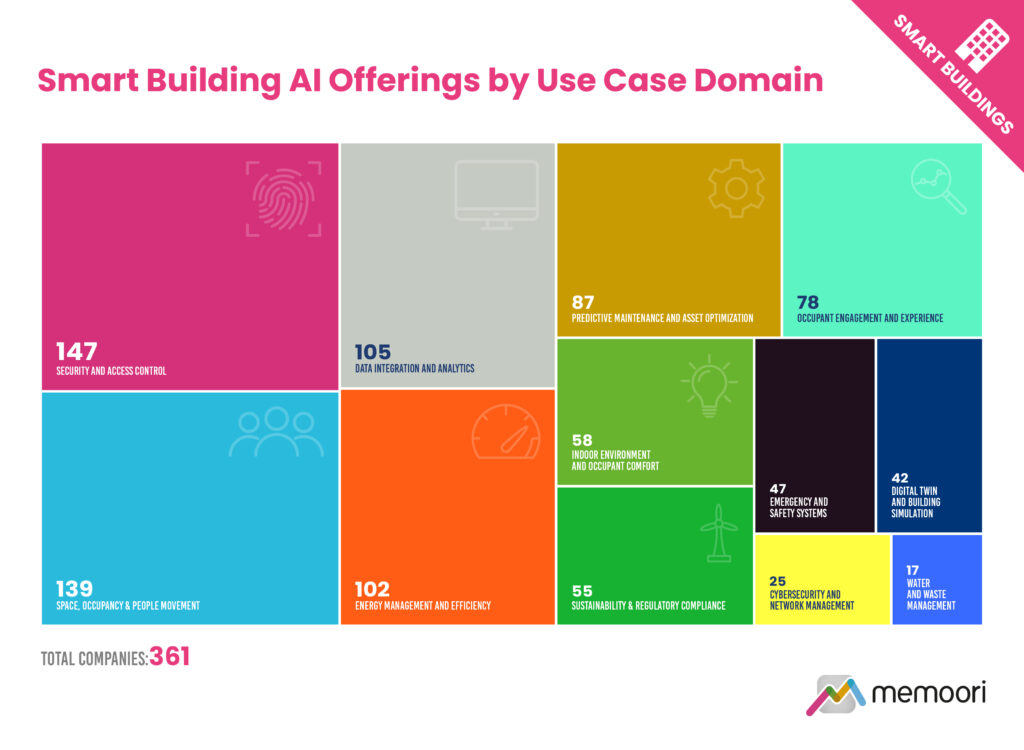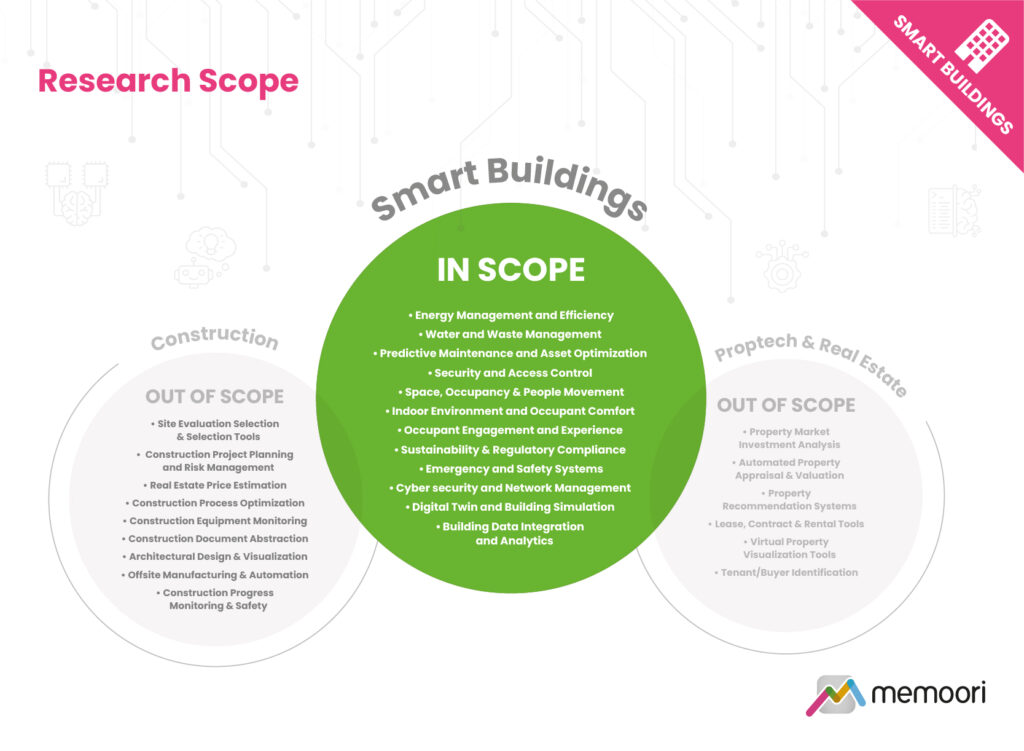This Report is a New 2024 Mapping and Analysis of Vendor AI Solutions for the Commercial Buildings Market
This new research builds on Memoori’s previous 2021 Artificial Intelligence (AI) market analysis, exploring the immense progress that has occurred both in the capabilities of AI and the growing vendor landscape enabling smarter, more sustainable, and more responsive commercial buildings.
The in-depth analysis maps out the global landscape of smart building AI companies, providing a clear picture of the market’s structure, and allows the reader to assess the maturity and potential of various AI applications and identify vendors shaping the industry.
It includes, at no extra cost, a spreadsheet that assigns all 361 companies identified (a 42% increase from the 255 companies we identified in 2021) to 66 distinct individual AI use cases. Together with its sister report it is by far the most complete assessment of the impact of AI on commercial buildings published to date.
It is the second in a 2-part series of reports, with the first report providing a review of AI technologies, opportunities and use cases. Both these reports are included in our 2024 Premium Subscription Service, which also gives access to our chatbot AIM, where you can query all our research using the power of Large Language Models (LLMs).

KEY QUESTIONS ADDRESSED
- Who are the key players shaping the future of AI commercial building applications? The report provides a granular analysis of 361 companies that we identified as operating in the AI space, segmenting companies by use case, company age, and company size. The spreadsheet that comes with the report provides further in-depth analysis assigning companies to each of the 66 distinct individual use cases where AI is being actively developed for use in the smart buildings market.
- What are the AI strategies of the major players? The report examines the strategic positioning of 17 major players whose offerings typically span multiple use cases for AI. It explores the strategies, positioning and recent innovations of leading building automation firms (e.g. Carrier, Honeywell), big tech (e.g. Amazon, Microsoft), and semiconductor companies (e.g ARM, NVIDIA).
- What does the investment landscape for AI in commercial buildings look like? The report looks at the average total disclosed funding and the number of funded private companies across various countries.

WITHIN ITS 179 PAGES AND 37 CHARTS AND TABLES, THE REPORT FILTERS OUT ALL THE KEY FACTS AND DRAWS CONCLUSIONS, SO YOU CAN UNDERSTAND EXACTLY HOW AI TECHNOLOGY WILL BE APPLIED TO COMMERCIAL BUILDINGS AND WHY;
- The report is focused on the use cases that relate directly to the ongoing operations of commercial buildings, such as building performance, sustainability, and the occupant experience. The scope does not include AI applications for design and construction phases.
- Across 12 distinct use case domains, encompassing a total of 66 individual use cases, Security and Access Control emerges as the most popular domain (40.7%), followed by Space, Occupancy & People Movement (38.5%), Data Integration and Analytics (29.1%), and Energy Management and Efficiency (28.3%).
- In terms of the number of private AI companies being funded, the US is the clear leader with 88, BUT China has the highest average disclosed funding per company at $287 million.
For Only $2,000 USD this report provides valuable information to companies so they can improve their strategic planning exercises AND look at the potential for developing their business through implementing AI technology.
WHO SHOULD BUY THIS REPORT?
The information contained in this report will be of value to all those engaged in managing, operating, and investing in commercial buildings (and their advisers) around the world. In particular, those wishing to understand the global landscape of AI & Machine Learning companies in commercial real estate will find it particularly useful.
Table of Contents
- Preface
- Research Scope & Methodology
- Executive Summary
- 1. Market Landscape and Dynamics
- 1.1 The Global Landscape of Smart Building AI Companies
- 1.2 Smart Building AI Market by Use Case
- 1.3 Smart Building AI Market by Company Age
- 1.4 Smart Building AI Market by Company Size
- 2. Competitive Landscape by Use Case
- 2.1 Energy Management and Efficiency
- 2.2 Water and Waste Management
- 2.3 AI Hardware and Compute
- 2.4 Security and Access Control
- 2.5 Space, Occupancy, and People Movement
- 2.6 Indoor Environment and Occupant Comfort
- 2.7 Occupant Engagement and Experience
- 2.8 Sustainability and Regulatory Compliance
- 2.9 Emergency and Safety Systems
- 2.10 Cybersecurity and Network Management
- 2.11 Digital Twin and Building Simulation
- 2.12 Data Integration and Analytics
- 3. The Strategic Positioning of Key Players
- 3.1 Building Automation Firms
- ABB
- Carrier
- Honeywell
- Johnson Controls
- Schneider Electric
- Siemens
- 3.2 Major Tech Firms
- Amazon
- Cisco
- IBM
- Microsoft
- Samsung
- 3.3 Major Semiconductor Firms
- AMD
- ARM
- Intel
- NVIDIA
- Qualcomm
- 3.1 Building Automation Firms
- 4. M&A & Investment
- 4.1 Mergers and Acquisitions
- 4.2 Investment Trends
- Geographic Investment Trends
- Notable Investment Deals
- 1. Market Landscape and Dynamics
List of Charts and Figures
- Fig 1.0 – Research Scope
- Fig 1.1 – Regional Distribution of Smart Building AI Companies
- Fig 1.2 – AI & Machine Learning Use Cases in Smart Commercial Buildings
- Fig 1.3 – Smart Building AI Offerings by Use Case Domain
- Fig 1.4 – Most Commonly Served Individual Use Cases
- Fig 1.5 – Number of Use Cases Served by Company
- Fig 1.6 – Distribution of Smart Building AI Companies by Age
- Fig 1.7 – Median Company Age by Use Case Domain
- Fig 1.8 – Distribution of Smart Building AI Companies by Size
- Fig 1.9 – Average Company Size by Use Case Domain
- Fig 1.10 – Average Increase in Headcount
- Fig 2.1 – Notable Smart Building AI Companies
- Fig 2.2 – AI for Energy Management & Efficiency in Commercial Buildings
- Fig 2.3 – AI for Water and Waste Management in Commercial Buildings
- Fig 2.4 – AI for Predictive Maintenance and Asset Optimization in Commercial Buildings
- Fig 2.5 – AI for Security and Access Control in Commercial Buildings
- Fig 2.6 – AI for Space, Occupancy & People Movement in Commercial Buildings
- Fig 2.7 – AI for Indoor Environment and Occupant Comfort in Commercial Buildings
- Fig 2.8 – AI for Occupant Engagement and Experience in Commercial Buildings
- Fig 2.9 – AI for Sustainability & Regulatory Compliance in Commercial Buildings
- Fig 2.10 – AI for Emergency and Safety Systems in Commercial Buildings
- Fig 2.11 – AI for Cybersecurity and Network Management in Commercial Buildings
- Fig 2.12 – AI for Digital Twin and Building Simulation in Commercial Buildings
- Fig 2.13 – AI for Data Integration and Analytics in Commercial Buildings
- Fig 4.1 – Global Investment Landscape in AI for Commercial Buildings

